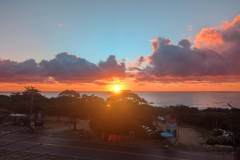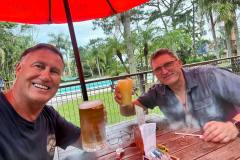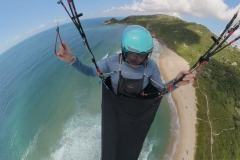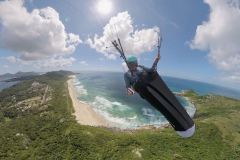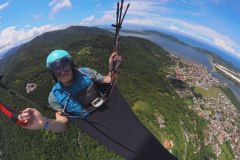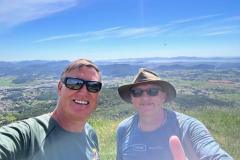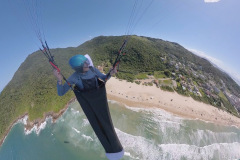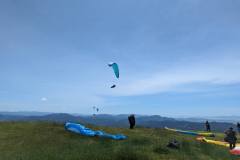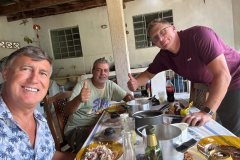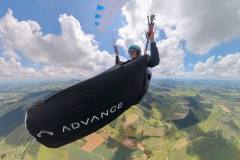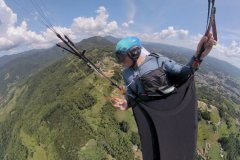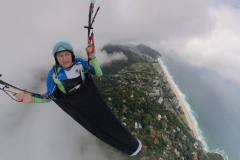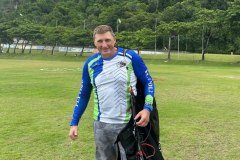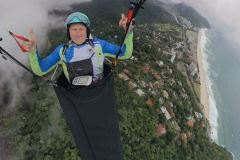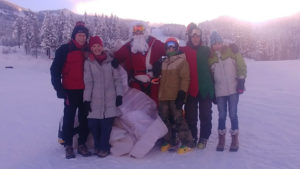Posts Tagged ‘Gleitschirm’
I am back from Brazil… 9 days, great experience, lots of flying, great food and people.
I was not ready for this at all and would have never done this if the kids would not have insisted on accepting the invitation from Frank.
Frank Kernick, who is a long time family friend, is the one who connected Penny and me and the kids call him “Uncle Frank”
Frank was already in Brazil and sent me a business class ticket to join him on his paragliding trip to join him.
I started the trip down south by Floripa flying along the coast and interior mountains, then traveling to the mountains NorthEast of Sao Paulo and then driving and flying in Rio de Janeiro.
Frank was very aware of what the weather was doing and that is why we traveled to different places… he is an amazing tour guide and did all the drinking for me as well. Thanks again Frank!
For me it was very hard to go to the airport without Penny… It felt so strange and very emotional. The hardest and most emotional day was Penny’s birthday by waking up with a beautiful sunrise. I was able to fly at 2 different coastal sites for hours that day… felt like she was with me all along.
As to the kids, both are doing well considering the circumstances.
Katia is back working at Panorama and has a lot of support and fun with her colleagues and friends. Thanks again to Stacy and her family for having their house open anytime for Katia and treating her as one of their own.
Erik is busy in North Vancouver with school and Hockey. Thanks to a very helpful and supporting team, coaches and a huge thank you to Erik’s billet family Terri, Steve, Logan and billet brother Jaxon, simply outstanding.
I, and maybe Katia, will be going to Penticton March 13-17 to watch Erik’s play-offs. Erik will come home with me/us after the playoffs for a week or so. We plan to do some skiing or other activities together as a family… Life goes on and we do feel and know that Penny is always with us, like a guardian angel and smiling when she can watch us living life with the spirit she showed us.
For those who want to see more of the pictures, I do have a album at
https://photos.app.goo.gl/rEFJMwUapEgizmyn6
Pilots tasks will be dropping Easter eggs (plastic bags filled with snow) and target landings at the designated landing site (Golf driving range). And if possible race out to the valley to Lake Windermere.
Not just about flying, it is also about socialising with pilots, family and friends.
Free social and paragliding event. Pilot lift ticket is $40/day.
Pilots meeting is March 30th at 8:30 am at the day-lodge.
Let me know who is planning to come this year so we can make arrangements for the Saturday evening dinner.
Contact Max Powers at max@flyingMax.com

Seasons Greetings and a Happy New Year from our family to yours!
The 2018/2019 Panorama Paragliding season has started.
If you plan to fly at Panorama, simply read the Panorama paragliding guidelines , then send me an e-mail with your HPAC number (including valid until date) and your paragliding level of experience to max@flyingMax.com, in order to get the Panorama Paragliding waiver form. This form is required for you to get you special priced Panorama “ski/flying” ticket from guest services. For first time paraglider pilots to Panorama, we will need to set up a meeting prior to your first flight for an orientation of the take off/landing spots and review the rules.
Happy Holidays and all the best for 2019!
Max & Penny
Merry Christmas and a happy, healthy 2018 from our family (Max, Penny, Katia & Erik) to everyone who knows us.
2017 has been a very good year for us and we like to thank everyone who has been a part of it. This does not only mean business, it means everyone who has been a part of our life’s.
In the mean time, here are a couple pictures and videos of the last couple days at Panorama.
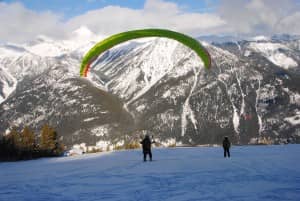 What an incredible ski and fly season we have so far at Panorama Mountain Resort. Lots and very good snow and amazing flying conditions.
What an incredible ski and fly season we have so far at Panorama Mountain Resort. Lots and very good snow and amazing flying conditions.
Due all the pictures and videos posted in the last month we have more and more people planning to come to Panorama to fly in winter.
To make things easier for everyone new and as a refresher I will post parts of last years post again.
All the best and happy landings
Max & Penny
===========================================
Winter in Canada, for most paragliding pilots, means to either dream about flying or going south to find warm thermals.
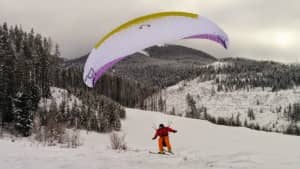 In Invermere however, we are a bit different, as we are very lucky to have the great Panorama Mountain Resort, which offers downhill skiing, Nordic skiing, snowshoeing, amongst other great activities, and also welcomes paragliding pilots.
In Invermere however, we are a bit different, as we are very lucky to have the great Panorama Mountain Resort, which offers downhill skiing, Nordic skiing, snowshoeing, amongst other great activities, and also welcomes paragliding pilots.
January and February are super smooth months to fly due the cold dense air and it lets you enjoy the extra glide you are getting with it.
At the beginning of March, when the snow starts melting off the trees, you will see the beginning of the nice, wide and smooth thermals, and start doing your first XC flights of the year. The thermals are typically wider and smoother than in the spring and early summer months, as they generate from a bigger area (the trees), in comparison to generating from dry ground (the ski runs with no snow) and are great to work slowly into XC flying for the season.
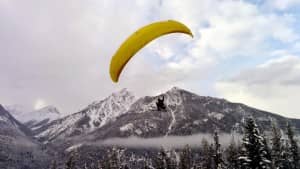 We have been flying at Panorama in the winters for about 20 years, but it seems that a lot of pilots avoid coming as they are probably thinking of the cold, harsh winters of Alberta. Sure, it can be cold here too, but remember, it is usually about 10 degrees warmer on this side of the Rockies.
We have been flying at Panorama in the winters for about 20 years, but it seems that a lot of pilots avoid coming as they are probably thinking of the cold, harsh winters of Alberta. Sure, it can be cold here too, but remember, it is usually about 10 degrees warmer on this side of the Rockies.
I would like to share some tips here in my blog to help others who are interested, and who were not able to be here for this weekend.
Panorama offers 2 launch sites:
- First choice. and most used launch site is 2/3 up the mountain at the top of Roller Coaster, below the outhouses. (870m vertical). This is where the Cappuccino Hut used to be for those who remember it! This is an easy, but shallow launch site and accommodates up to 5 gliders facing NW.
- Summit Launch “Roy’s Run” (1200m vertical) is a steep, wide open launch (up to 4 gliders, strategically layed out) facing W to SW. This launch is only for good skiers. It can be a tricky launch site to set up your wing as the slope is steep and the wing tends to slide down while you get into your harness. As well if the wind picks up at all, it will slide down too. Do not set up your wing at the very top of Roy’s run layed out on the “easy way road”. This will be conflicting with the ski traffic.
For the two different launch sites you need to adjust your launch techniques simply due to the nature which they are.
At the Summit takeoff, overall, the wing inflates very fast and will have a tendency to overshoot due the steep terrain. The summit take-off site does not allow you to make any mistakes as things happen very fast, and you can end up in the trees beside the run very easily if you do not work with the wing at the speed required.
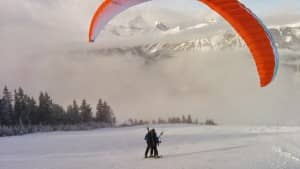 If you are just getting used to winter flying, I do recommend to start 2/3 up the ski hill on the shallow launch. The tricky and unusual part at this launch is to lead the canopy for much longer than you are used to. Furthermore, you also need to be more patient and allow yourself and the wing to pick up speed for take-off. The takeoff process on skis at this launch site are way slower than you would do by foot.
If you are just getting used to winter flying, I do recommend to start 2/3 up the ski hill on the shallow launch. The tricky and unusual part at this launch is to lead the canopy for much longer than you are used to. Furthermore, you also need to be more patient and allow yourself and the wing to pick up speed for take-off. The takeoff process on skis at this launch site are way slower than you would do by foot.
This is why we position our self for the launch position as close as possible to the trailing edge and be a bit offset from the centre of the wing. This way as you turn downhill to start skiing you can ski (turn) into the position where you want to inflate the wing and be in the centre of your wing. If you start with tension on the lines, you might inflate the wing sideways as you stand sideways to the hill with your skis and might not have enough momentum to inflate the wing due to being sideways to the hill and with your skis on.
See the following 2 videos. One shows you when you do not guide the wing for long enough and not being able to get airborne, and the second video shows you how much you need to charge forward and patience you need to get airborne.
I want to thank Panorama Mountain Resort again for all their support to the pilots, for the sport, and allowing us to fly for so many years.
Please respect Panorama Mountain Resort’s basic rules so we can enjoy it for many more years.
- Novice Rating (P2)
- HPAC Liability Insurance
- NO Speedwing flying, Paragliding only
- All pilots to sign the 2015/2016 waiver
- Pilots are required to get in touch with Max Fanderl (max@flyingMax.com) to get the waiver forms
Please respect the following points:
- No flying over the bottom high-speed Chair (Mile 1 Quad) area at all.
- No landings at the village. Only land on designated landing site or on Golf course if it gets to windy.
- No launches after 3:00 pm
- Stay at least 150 feet above lifts and ski runs
- Pilots need to have skis or a snowboard to get a ride with the lift
- Contact RK Heliski before you head up the Mountain at 250 342-3889.
This is just to let them know we are flying as they will inform their pilots of the activities.
More detailed and current information about of flying at Panorama Mountain Resort is at https://flyingmax.com/area/panorama/
Here is a video of a flight from Panorama to Invermere
The xAlps finished Friday July 19th at noon. This is 12 days after the start and was the minimum time set for the race. Crigel Maurer set a new record and finished the race in just under 7 days and it took more then 2 days longer for the next guys to arrive in goal. From the start, I felt pretty good and was very happy with my pace and performance until I had to do an emergency landing past Innsbruck (by Seefeld) into restricted airspace and I received a 48 hour penalty. I could have done a tree landing (in very rough conditions) on top of a ridge to avoid the penalty, but I decided to land 500 meters lower, and to my disadvantage, safely in a field. The good part was that Christa Vogel and Juergen Kraus (flying friends from the 80’s) lived near by and we could enjoy visiting them and were treated with their amazing hospitality. It got even better as the kids just showed up for a visit and stayed with us for the 2 days. It was fun to invite all the other competitors for a snack or meals while
they passed us, or landed in a field close by. After 2 days of watching 13 pilots pass us, we had to refocus and get back into race mode. Thanks again for the mental support from Stewart Midwinter to be able to start my own race and adventure from that position. We came from the very back of the pack (only 1 hour ahead of the last person) and fought ourselves into position 23. I was enjoying being in a close pack with such a great group of people/pilots and I was always close to my good friend, Andy Froetscher, who finished 17th. I was hoping to finish the race with him or better. Overall, it was an amazing race with very good flying conditions. We experienced a lot of set backs due the lack of local “area” knowledge. It was very frustrating thinking you know where thermals “should be”, what ridges and terrain would work better than others, only to find myself flushed down from 3500m to the ground and ended up having to hike up very high mountain passes more often than the “locals” The good weather also brought a lot of windy and dangerous conditions as well. We had flights in plus 50 km winds, in rain and thunder storms, but at the same time we had some long flights (one over 150 km) flying over glaciers and very beautiful terrain. We had hikes in areas we never would have gone to and met such a wide variety of people along the way, some who we’re sure were the start of a long friendship. All this would not have possible to do without the support I received. Thanks again to Mik Broschart for all his technical support, and who drove with his “fancy” RV and made it possible that Penny could walk and fly most of the route with me. Penny did an amazing job as a pace setter, along the flats, up the mountains, and because she figured she needed more of a workout, she’d run back down to the valley!! My stats for hiking was, 6 km/hr, 471 km distance and 40 km elevation gain. I would say that Penny did at least 90% of that, plus going down, cooked dinners, cleaned most of the dishes, checked weather, and was up earlier than Mik and I everyday to have breakfast ready, and everything ready and prepared for the day ahead ….. she is more then living up to her name (Powers). I would also like thank everyone who cheered us on and supported us throughout our training and during the race, A photo gallery will follow soon.
Wow, where is the time going??
video to see what we have done so far.
What a fantastic day. Dave and I started the day with a 1500 meter hike up to the Stanser Joch. This site overlooks Achensee and down the main Inntal valley. Once we got up (1:00pm) we watched already other para-gliders and gliders go by. We had a quick lunch and got ready to get airborne. The conditions were perfect and I could sky out right away. Once I got up, I flew along the Inntal valley passing by Innsbruck to Seefeld. From there I did a huge valley crossing to get to the Zugspitze area. I arrived there low with about 400 meter over the valley floor, but was able to find a small thermal and managed to climb out to 3000 meters. Once up there I could fly to the Zugspitze. At my first attempt to get to the Zugspitze turn point I got low and had to come back for a second time to get into
the 100 meter turn point radius. I sure hope I can make this turn point same way in the race, otherwise this would end up in a huge hike.
After the Zugspitze I headed back out to the Inntal to fly towards the next turn-point Sulden. I flew for about another 40 km and landed between Imst and Landeck. On the way to Landeck I decided to turn around and land next to a big highway gas station to make it easy for Dave to find me. Dave had a 3.5 hour flight himself and landed close to the car. He is super stoked as this was
his longest flight he ever had. We drove back to Nova and hope that my harness has now arrived. My Mentor3 light is still not finished and I might get a Mentor 3 large today as well as I flew the Mentor 3 medium for the last couple of days. Hello to everyone and we will keep you posted as long we have an Internet connection. More photos at https://plus.google.com/photos/107366320201211493303/albums/5889218649628650273
1031 km, as the crow flies, is the distance of the 2013 route of the xAlps. This is a lot of terrain to cover and hard to navigate by foot. Many people question how would one conquer this task, and how would one complete it. When spectators, such as non paragliding pilots try to answer this question,most of them might think of hiring guides. Some might even think that, given a chance and ability, it might be easier to paraglide across the high mountain passes rather than hike them. This might be correct if you are at the right place at the right time to take advantage of good weather conditions and flying possibilities. These variables and the present physical/mental condition of the athletes, make the xAlps such a popular and interesting race for anyone to follow, whether you are a participant/athlete in the race, a paraglider pilot or only a spectator. Every athlete has a live tracking device with them and the athletes can be followed throughout the race live at www.RedBullxAlps.com. In 2011 the race had over 2 million visitors on the website following it. It is very interesting understanding the perspective of the performer/athlete and also the perspective of the viewer/observer. The observer is entertained by watching the tactics of the athletes and tries to figure out the decision making of these performers. As it often is, the observer seems to know best what the performer should do! We hear it all the time. In sports, competitions, watching a movie or a play, the commentators and spectators feel they know better what the performer should be doing. And quite often the observer might have a better idea of what is going on and see the overall picture, and how to proceed with it. At the same time however, an observer is often surprised by the performers decision as the observer does not always know what is going on in the performers mind, their entire “game plan” and also the physical and mental condition or background knowledge of the performer. To assist an athlete/performer with the overall picture of how the event should be played, we use coaches/leaders. A good coach/leader helps to eliminate or reduce overall difficulties or problems, work on different tactics and is a liaison with feedback from supporters
of what the performer is doing. The use of coaches in the sports industry is very much accepted and they play a huge part in all sports. The equivalent in the business world, would be a mentor. If you think about, a good manager should be the coach/leader, however, we see it all the time, the manager is also performing and can have a hard time seeing the overall picture. Even in our private or family life we could use a coach, who simply can be a couple of friends to talk to. For my preparations in the race, I always try to step out of the current situation I am in, and try to watch my actions from the outside. Sometimes I envision myself sitting in front of a TV, watching the event play itself out, and try to analyze this situation as an observer, coach, commentator or spectator, and in that position think about what the right decision will be for the next step. Trying to evaluate oneself like this, will only work to a certain extent. The xAlps race is not only about the pilot/athlete. It is about a team working together to achieve a common goal – getting the pilot to Monaco. I have to say that I am very fortunate to do the xAlps with my partner Penny, as she is a very good coach and motivator and the best of all is that we both have so much fun while preparing for the xAlps and then racing. In the 2013 xAlps, a team will now be allowed to have 2 supporters, which could, or might, make things much harder, as we know that too many chefs spoil the broth. But if you have the right team players, you quadruple the benefit. Penny and I are very excited that we found the best 2nd supporter/coach we could ask for. Mik Broschart is a long time friend, has a lot of connections, knowledge of the race and the sport, highly motivated, got the time and got the support from his family (thanks again Kristine) to make Team Canada complete.

